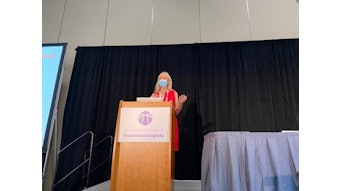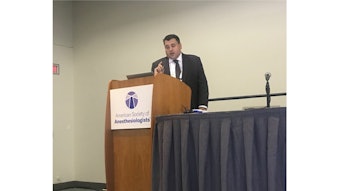Keep direct laryngoscopy in your armamentarium and add a rescue cart
Both are necessary to prep for airway management scenarios inside and outside the OR.

Despite the shift toward the use of videolaryngoscopy (VL), which uses video camera technology to visualize airway structures and facilitate endotracheal intubation, it’s important to have direct laryngoscopy (DL) as a backup.
“Safety is about redundancy, and it’s important to have more than one plan to manage the airway in case of VL failure,” said Lauren C. Berkow, MD, FASA, Professor of Anesthesiology and Chief of the Division of Neuroanesthesia and Director of Anesthesia Supplies and Equipment at the University of Florida College of Medicine in Gainesville.
In 2021’s session, “Current Controversies in Airway Management,” Dr. Berkow discussed the limitations of VL and why DL should continue to be used and taught.
Citing the literature, there’s no difference in success rates between the two airway techniques, Dr. Berkow said. But DL has been used as a successful rescue technique after VL failure in many studies. VL provides a better glottic view, but there’s the potential for soft tissue injury, including the palate and tonsils.
“Injuries can happen because there’s a blind spot with VL,” Dr. Berkow said.
Increased rates of oxygen desaturation during VL have also been reported in the literature. “VL may be dangerous in some patients. Patients with trauma or severe head injury had a higher mortality and hypoxia than patients with DL,” she said.
The majority of VL injuries are found at extubation, or re-evaluation of the airway, not during the initial intubation.
“These injuries can happen because the intubator is focused on the video screen and inserts the endotracheal tube blindly.
To reduce VL injury, Dr. Berkow recommended using direct vision to insert the VL blade, looking at the screen to obtain glottis view, returning to the mouth to place ETT under direct vision, and returning to the screen to advance ETT into the trachea. “But don’t retire the laryngoscope,” she said. It should remain a central part of anesthesiology practice competency. Plus, it’s inexpensive. “For the cost of a single video laryngoscope, a hospital could purchase many laryngoscopes,” she said.
To maximize patient safety, especially in a non-OR anesthesia (NORA) environment in which sicker and obese patients are likely to present, increasing the risk of respiratory events, Felipe Urdaneta, MD, Professor of Anesthesiology at the University of Florida and VA Medical Center in Gainesville, recommended having a NORA airway cart or bag organized with essential intubation and oxygenation equipment. Being prepared is part of the ASA Guidelines for Ambulatory Anesthesia and Surgery, which recommend that at a minimum, all settings should have a reliable source of oxygen, suction, resuscitation equipment, and emergency drugs, he said.
“If you organize your equipment in a NORA cart into different stages of anesthesia management planning, you’ll have a better chance of negotiating crises that present on a daily basis,” he said. “VL should be part of your initial plan for intubation, but that doesn’t mean you have to use it.”
Visit Anesthesiology Today Annual Meeting Edition for more articles.










![Sharks[2]](https://img.ascendmedia.com/files/base/ascend/hh/image/2021/10/Sharks_2_.616369899ebe1.png?auto=format%2Ccompress&bg=fff&fill-color=fff&fit=fill&h=191&q=70&w=340)
